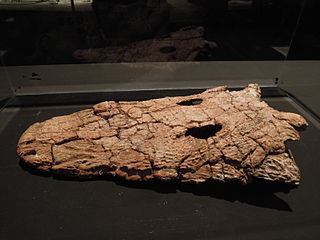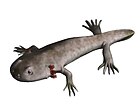
Lepospondyli is a diverse taxon of early tetrapods. With the exception of one late-surviving lepospondyl from the Late Permian of Morocco, lepospondyls lived from the Early Carboniferous (Mississippian) to the Early Permian and were geographically restricted to what is now Europe and North America. Five major groups of lepospondyls are known: Adelospondyli; Aïstopoda; Lysorophia; Microsauria; and Nectridea. Lepospondyls have a diverse range of body forms and include species with newt-like, eel- or snake-like, and lizard-like forms. Various species were aquatic, semiaquatic, or terrestrial. None were large, and they are assumed to have lived in specialized ecological niches not taken by the more numerous temnospondyl amphibians that coexisted with them in the Paleozoic. Lepospondyli was named in 1888 by Karl Alfred von Zittel, who coined the name to include some tetrapods from the Paleozoic, that shared some specific characteristics in the notochord and teeth. Lepospondyls have sometimes been considered to be either related or ancestral to modern amphibians or to Amniota. It has been suggested that the grouping is polyphyletic, with aïstopods being primitive stem-tetrapods, while recumbirostran microsaurs are primitive reptiles.

Temnospondyli is a diverse order of small to giant tetrapods—often considered primitive amphibians—that flourished worldwide during the Carboniferous, Permian, and Triassic periods. A few species continued into the Jurassic and Cretaceous periods. Fossils have been found on every continent. During about 210 million years of evolutionary history, they adapted to a wide range of habitats, including freshwater, terrestrial, and even coastal marine environments. Their life history is well understood, with fossils known from the larval stage, metamorphosis, and maturity. Most temnospondyls were semiaquatic, although some were almost fully terrestrial, returning to the water only to breed. These temnospondyls were some of the first vertebrates fully adapted to life on land. Although temnospondyls are considered amphibians, many had characteristics, such as scales and armour-like bony plates, that distinguish them from modern amphibians (lissamphibians).

Metoposaurus meaning "front lizard" is an extinct genus of stereospondyl temnospondyl amphibian, known from the Late Triassic of Germany, Italy, Poland, and Portugal. This mostly aquatic animal possessed small, weak limbs, sharp teeth, and a large, flat head. This highly flattened creature mainly fed on fish, which it captured with its wide jaws lined with needle-like teeth. Metoposaurus was up to 3 m long and weighed about 450 kg. Many Metoposaurus mass graves have been found, probably from creatures that grouped together in drying pools during drought.

Eryosuchus is an extinct genus of capitosauroid temnospondyl amphibian from the Middle Triassic of northern Russia. It was a very large predator: largest specimen known could reach up to 3.5 m (11.5 ft) in length, with a skull over 1 m long.

Gerobatrachus is an extinct genus of amphibamid temnospondyl that lived in the Early Permian, approximately 290 million years ago (Ma), in the area that is now Baylor County, Texas. When it was first described in 2008, Gerobatrachus was announced to be the closest relative of Batrachia, the group that includes modern frogs and salamanders. It possesses a mixture of characteristics from both groups, including a large frog-like head and a salamander-like tail. These features have led to it being dubbed a frogamander by the press. Some more recent studies place Gerobatrachus as the closest relative of Lissamphibia, the group that contains all modern amphibians including frogs, salamanders, and caecilians, or place modern amphibians far from Gerobatrachus within a group called Lepospondyli.

Konzhukovia is an amphibian genus that belongs to an extinct group of temnospondyls, the largest clade of basal tetrapods including about 198 genera, 292 species, and more than half of which were alive during the early Mesozoic period. The animal was a predator that lived about 260 million years ago, and could get up to about three meters in length. Specifically, Konzukovia lived during the Permian, between 252 and 270 million years ago according to the type of rock the fossil was found in. There are three species within this genus, K. vetusta, K. tarda, and K. sangabrielensis, the first two originating from Russia while the latest originating from Southern Brazil. The discovery of this specimen in Southern Brazil provided more evidence to support the idea that during this animals existence, there was a “biological corridor” because of the supercontinent Pangea, allowing these species to be found so far apart from each other. Konzhukovia belongs to the family Archegosauridae, a family consisted of large temnospondyls that most likely compare to modern day crocodiles. Since the discovery of the latest species, K. sangabrielensis, Pacheco proposes that there must be the creation of a new family, Konzhokoviidae, a monophyletic group in a sister-group relationship with Stereospondlyi in order to accommodate the three species. Konzhukovia skulls usually exhibit typical rhinesuchid features including an overall parabolic shape, small orbits located more posteriorly, and the pterygoids do not reach the vomer. These animals were long-snouted amphibians that had clear adaptations made for fish catching, as well as exemplifying aquatic features.

Benthosuchus is an extinct genus of temnospondyl amphibian from the Early Triassic of Russia. It was primarily aquatic, living in rivers and lakes. Multiple species are known, with the largest reaching about 2.5 meters in length.

Limnarchia is a clade of temnospondyls. It includes the mostly Carboniferous-Permian age Dvinosauria and the mostly Permian-Triassic age Stereospondylomorpha. The clade was named in a 2000 phylogenetic analysis of stereospondyls and their relatives. Limnarchia means "lake rulers" in Greek, in reference to their aquatic lifestyles and long existence over a span of approximately 200 million years from the Late Carboniferous to the Early Cretaceous. In phylogenetic terms, Limnarchia is a stem-based taxon including all temnospondyls more closely related to Parotosuchus than to Eryops. It is the sister group of the clade Euskelia, which is all temnospondyls more closely related to Eryops than to Parotosuchus. Limnarchians represent an evolutionary radiation of temnospondyls into aquatic environments, while euskelians represent a radiation into terrestrial environments. While many euskelians were adapted to life on land with strong limbs and bony scutes, most limnarchians were better adapted for the water with poorly developed limbs and lateral line sensory systems in their skulls.
Almasaurus is an extinct genus of trematosaurian temnospondyl within the family Latiscopidae. It is known from several skulls and some postcranial material found from the Argana Formation in Morocco, which dates back to the Late Triassic.

Rhineceps is an extinct genus of temnospondyl amphibian in the family Rhinesuchidae. Rhineceps was found in Northern Malawi in Southern Africa known only from its type species R. nyasaensis. Rhineceps was a late Permian semi-aquatic carnivore that lived in streams, rivers, lakes or lagoons. Rhineceps is an early divergent Stereopondyl within the family Rhinesuchidae, which only existed in the late Permian (Lopingian) and failed to survive the Permian-Triassic extinction unlike other stereospondyl families.
Rileymillerus is an extinct genus of temnospondyl amphibian from the Late Triassic Post Quarry in the Dockum Group of Texas that was described by John Bolt and Sankar Chatterjee in 2000. The holotype, a nearly complete skull with articulated jaws, is housed at the Museum of Texas Tech University. The genus is named for Riley Miller, who allowed Chatterjee to work on the Post Quarry, and the species is named for the paleontologist John Cosgriff.

Anaschisma is an extinct genus of large temnospondyl amphibians. These animals were part of the family called Metoposauridae, which filled the crocodile-like predatory niches in the late Triassic. It had large skull about 62 centimetres (24 in) long, and possibly reached 3 metres (9.8 ft) long. It was an ambush hunter, snapping up anything small enough to fit in its huge jaws. It was very common during the Late Triassic in what is now the American Southwest.

Capitosauria is an extinct group of large temnospondyl amphibians with simplified stereospondyl vertebrae. Mainly living as piscivores in lakes and rivers, the Capitosauria and its sister taxon Trematosauria were the only major labyrinthodonts that existed during the Mesozoic in ecological niches broadly similar to those of modern crocodiles, and some grew to very large sizes. At 6 meters in length, the Mid-Triassic Mastodonsaurus giganteus is not only thought to have been the largest capitosaur, but possibly also the largest amphibian to have lived. The latest known remains are from the Rhaetian of Germany and are referred to Cyclotosaurus.

Stenotosauridae is an extinct family of mastodonsauroid temnospondyls. It has included genera such as Stenotosaurus, Wellesaurus, and Procyclotosaurus.

Caerorhachis is an extinct genus of early tetrapod from the Early Carboniferous of Scotland, probably from the Serpukhovian stage. Its placement within Tetrapoda is uncertain, but it is generally regarded as a primitive member of the group. The type species C. bairdi was named in 1977.
Adamanterpeton is a genus of edopoid temnospondyl within the family Cochleosauridae. Two specimens were discovered in the fossil-rich Allegheny Formation of Linton, Ohio. The type species A. ohioensis was named in 1998. Adamanterpeton is rare in the Linton vertebrate assemblage, with other amphibians like Sauropleura, Ophiderpeton, and Colosteus being more common. Unlike other Linton vertebrates, Adamanterpeton may have been adapted to a terrestrial lifestyle.
Perryella is an extinct genus of dvinosaurian(?) temnospondyl from the Permian of Oklahoma.
Kashmirosaurus is an extinct genus of temnospondyl amphibian known from Permo-Carboniferous deposits in the region of Kashmir. It was originally named by English paleontologist Arthur Smith Woodward in 1905 as a species of Archegosaurus called Archegosaurus ornatus. More recently, the species has been recognized as being distinct from Archegosaurus, and it was placed in its own genus Kashmirosaurus in 1996. An additional species of Archegosaurus, A. kashmiriensis, was named in 1960 from the same deposits in Kashmir, and is now considered synonymous with Kashmirosaurus ornatus.

Rhachitomi is a group of temnospondyl amphibians that includes all temnospondyls except edopoids and dendrerpetontids. It was established as a clade name by German paleontologist Rainer R. Schoch in 2013, although the name had first been established in 1919 by British paleontologist D. M. S. Watson to encompass an evolutionary grade of temnospondyls leading to the group Stereospondyli. American paleontologist Alfred Romer used the term in a similar sense, grouping most Permian and Triassic temnospondyls under Rhachitomi. A similar name that appeared earlier in the scientific literature is Rachitomi, which was named by American paleontologist Edward Drinker Cope in 1882. Rachitomi was commonly used in the late nineteenth and early twentieth century to include early amphibians such as Eryops and Archegosaurus that had rhachitomous vertebrae. Many early tetrapods have vertebrae that are split into two parts below the notochord: a pleurocentrum and an intercentrum. In rhachitomous vertebrae, the intercentrum is large and semicircular, while the pleurocentrum divided into two smaller paired elements. Schoch defined Rhachitomi as a node-based taxon to include four major and well-supported clades of temnospondyls: Dvinosauria, Eryopidae, Stereospondyli and a clade formed by Zatracheidae and Dissorophoidea. Not all members of Rhachitomi have rhachitomous vertebrae; the largest subgroup, Stereospondyli, lacks pleurocentra. Below is a cladogram from Schoch's analysis showing the placement of Rhachitomi within Temnospondyli:

Nooxobeia is an extinct genus of dissorophid temnospondyl from the Early Permian (Guadalupian) of Oklahoma. The generic name is derived from the Arapaho word nooxobe, which means frog.






























